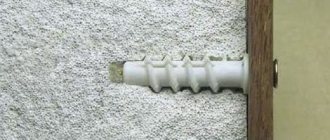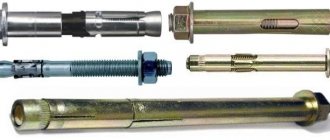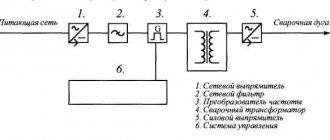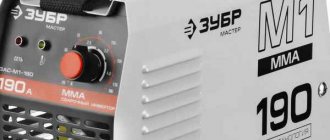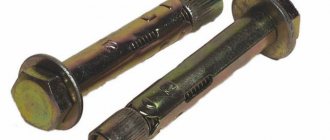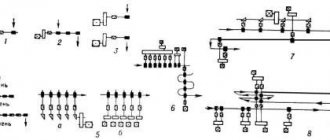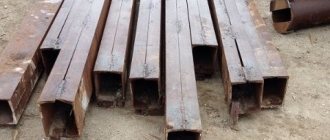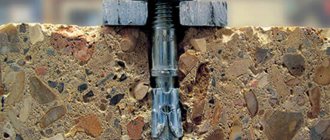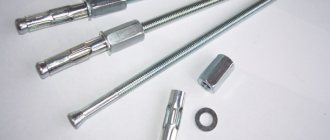Marking of anchor bolts
Since 2012, all anchor bolts have been marked in accordance with the interstate standard. Its requirements apply to the territory of the countries that have signed it. In this standard, the anchor bolt has the following designations:
- the first letter together with the number indicates the thread diameter, for example M8;
- the next number indicates the diameter of the drill that must be used to prepare the hole, for example 10;
- the number located after the slash means the thickness of the attached structure or product;
- the last digit located after the “x” sign indicates the minimum permissible depth of the prepared hole in millimeters, for example 90.
Combining all the designations, we get the following abbreviation - M10/35x100. On construction drawings and plans, the markings, in addition to digital symbols, have special signs. They are placed in a circle and indicate the type of anchorage used.
Anchor products manufactured in other countries have their own markings. For example, on anchors from the German company Fisher, the marking is as follows - FBN 12/100. The first letters indicate the name of the product. The number 12 indicates the diameter of the anchor taking into account the thread. The second digit determines the useful length. The number in the first square brackets corresponds to the useful length. The last two letters indicate that the anchor is equipped with a wide washer.
Therefore, to correctly select the type of anchor bolts, it is necessary to understand in detail the marking system and clarify the necessary characteristics.
Characteristics and dimensions of anchor bolts
In addition to the different sizes of structures, important parameters that are worth paying attention to are the sizes of anchor connections. Length can vary from 45 mm to 220 mm
Fasteners come not only in different lengths, but also with different diameters. The choice depends on the tasks at hand.
Size classification:
- Small ones. Their length is a maximum of 55 mm and their cross-sectional diameter is 8 mm.
- Average. Maximum length - 120 mm, cross-section - 12 mm.
- Large ones. Length - 220 mm, maximum diameter - 24 mm.
Each concrete anchor has its own designation. It encodes characteristics determined by the following indicators. For example, M8 10/60 - 115:
- Thread size. It is designated by the letter “M” and a number corresponding to the diameter of the bolt thread.
- Drill diameter. In this example, a hole is drilled for fasteners with a diameter of 10 mm. 60 is the approximate thickness of the component that is planned to be fixed.
- Anchor length. The last parameter is 115 mm.
How long can a 16 anchor hold?
Table 1. Dimensions, installation parameters and loads of anchors S-KA and S-KAK
| Marking | Anchor diameter , mm | Loads (compressed zone of concrete C20/25) |
| 16x90 | 16 | 21,8 |
| 16 /5x123 | 16 | 25,1 |
| 16 /20x138 | 16 | 25,1 |
| 16 /50/168 | 16 | 25,1 |
Anchor bolt with nut - weight, dimensions: what does GOST tell us?
Since all fasteners are complex installation products, they all have appropriate technical documentation. It is from such documents that we can find out technical parameters if necessary. For example, when choosing this or that fastener, we want to know whether the anchor fastening will withstand a weight of 100 kilograms or not. Thanks to the fact that there is documentation, we will receive an answer to our question.
To make it clearer, kgf is the designation of kilogram/force, where the calculation takes into account the mass of one kilogram and the force with which this kilogram exerts pressure on the scale. Further calculations are quite simple, 1 kgf is equal to approximately one kilogram of any object, based on this, such an anchor will support a product weighing 800 kilograms.
Also, absolutely any bolt has a corresponding GOST, which divides all fastening structures into varieties according to their ability to withstand a certain load, the size and diameter of the fastening element. On large construction sites, such documentation helps in the selection of fastening elements and the purchase of appropriate materials.
Wedge anchor B fvz
Wedge anchor B fvz
More details
Wedge anchor B fvz
WEDGE ANCHOR B FVZ Wedge anchor B FVZ is the optimal fastening element option for internal..
More details
The company's website presents all types of wedge anchors with their detailed descriptions. Ordering goods is very simple. All you need to do is fill out an application in your personal account or call the phone number listed on the website. Company managers will advise on all issues of interest.
Areas of use
The expansion anchor is considered one of the most practical and highly durable means of fixation. It allows you to fix a wide variety of surfaces; the anchor creates the most uniform friction with significant force along the entire length, which ensures increased ability to hold the structure. At the same time, the material of the structure itself must have increased density and a solid base.
Important! If there are internal cracks on the surfaces of the materials where the bolt will be fixed, then the load that the fastener can withstand is reduced many times over. An anchor with spacers is often needed when performing façade fastenings
An anchor with spacers is often needed when performing façade fastenings.
Self-expanding anchor can be used to fix:
- window frames;
- door structures;
- flights of stairs;
- suspended ceiling structures;
- chandeliers and other lamps;
- air ducts;
- fences;
- balustrades;
- engineering communications;
- consoles;
- bank terminals;
- foundation elements.
The mechanism of action of a self-expanding anchor is fundamentally different from the mechanism of action of a dowel. The outer part of the latter is in contact with the back of the hole only at some separately located points, while the spacer bolt is adjacent to it along its entire length.
How to attach?
In order to install an anchor type fastener, no matter with a ring or a hook, you must do the following
- After carefully determining the location (since it will no longer be possible to dismantle the fasteners), using a hammer drill or impact drill, drill a hole corresponding to the outer diameter of the spacer sleeve.
- Remove fragments of material and other slag from the hole; the best result can be obtained using a vacuum cleaner.
- Insert an anchor bolt into the hole, possibly using a hammer.
- When the spacer part of the anchor is completely hidden in the material, you can begin to tighten the spacer nut - you can use pliers for this. If the anchor has a special nut under the ring or hook, it is better to use a wrench and tighten it. The fact that the fastener is completely wedged can be judged by a sharp increase in the resistance of the screwed-in pin.
The following video talks about anchor bolts.
Bolt Load Calculation
The bolt head markings usually contain the following information:
- manufacturer's mark (JX, THE, L, WT, etc.);
- strength class;
- arrow “counterclockwise” (if left-hand thread).
The first number indicates the nominal tensile strength (tensile strength): 1/100 MPa (1/100 N/mm²; ~1/10 kg/mm²). Example: (strength class 9.8) 9*10=900 MPa (900 N/mm²; 91.71 kg/mm²).
The second number indicates the percentage of yield strength to tensile strength (tensile strength): 1/10%. Example: (strength class 9.8) 9*8=720 MPa (720 N/mm²; 73.37 kg/mm²).
The yield strength value is the maximum permissible working load of the bolt, above which irreversible deformation occurs. When calculating the load, 1/2 or 1/3 of the yield strength is used, with a double or triple safety margin, respectively.
Examples of material flow
An example would be a common kitchen fork. By bending it in one direction, you can get a completely different object, which means its fluidity is disrupted, which leads to deformation. In this case, the material only deformed, but did not break, which indicates a high degree of elasticity of the steel. Conclusion: maximum strength is much higher than yield.
Other kitchen equipment, such as a knife, will break if you try to change its shape. Conclusion: the knife has the same fluidity and strength; such a product can be called fragile, despite the fact that it is made of steel.
The percentage of elongation is an average indicator that demonstrates the length of the deformed part before the onset of failure. Figuratively, we can call this kind of bolts flexible, meaning precisely the ability to elongate.
The technical terminology for this is quite simple: elongation is nothing more than the percentage of increase in a sample compared to its original size.
How to properly install an anchor bolt with a nut - step-by-step diagram
Step 1: Anchor Hole Diameter
Before drilling a hole for the fastening, you need to select a concrete drill for a hammer drill of the required diameter. In this case, first of all, be guided by the dimensions of your mount. It is under no circumstances recommended to drill a hole if the bushing does not fit into it. It is better to go through the same diameter drill again, and the hole will become a little larger. If you drill out the fastening point with a drill of a larger diameter, the bushing can freely “walk” in it, while the spacer mechanism simply cannot perform its holding functions.
Step 2: Clear the mounting area of debris
It is no secret that after drilling, debris remains in the finished hole after using a hammer drill. It is these crumbs and dust that interfere with the installation of the bolt at the installation site. It is especially difficult to install a double-spacer mechanism into an uncleaned hole; such fasteners have a sleeve that is slightly wider than usual. Therefore, before installation, thoroughly clean the hole; if necessary, use a construction or household vacuum cleaner.
Step 3: Correct installation of heavy elements
After you have inserted the bolt into the hole, do not rush to mount your device while tightening the nuts; there is a more practical solution. After installing the anchor, without hanging the product, tighten the bolt with a wrench until it stops. Tightening must be carried out until the pin opens the bushing, and the fastening, so to speak, assumes operating mode. After this, you can place the nut on the studs, which are already firmly held in the mounting hole, install the device, and calmly tighten it with the nuts.
Source
Materials
The anchor material may also be different:
steel;
It is clear that each material has its own advantages and disadvantages. Steel fasteners with high strength cannot be used in aggressive environments, including high humidity. Galvanization significantly extends the service life of steel fasteners, but also increases its cost. Stainless steel grades A1, A2 or A3, used for the manufacture of anchor bolts, are not subject to corrosion, have high strength, but are expensive. Brass, despite not having the best strength characteristics, can be used not only for fastening in a humid environment, but also under water.
What kind of anchors are used in hollow bricks?
Chemical Anchor for Hollow Brick
, solid
brick
and concrete ITH 345 Ve Sormat 345 ml is a two-component, fast-curing vinylester-based resin (no styrene).
Interesting materials:
How to make a corner? How is bottled water made? How is green manure made? How to make tea in a samovar? How to make toys from cotton wool? How to make an infusion in a water bath? How to make non-woven fabric? How to clean the Samsung eco drum? How to clean the drum? How to make fertilizer for cucumbers from nettles?
Material hardness
Brinell hardness is a characteristic that allows you to determine the hardness of a material.
Stainless steel fasteners are also equipped with special markings on the top of the fastener.
Type of steel A2 or A4 and tensile strength - 50, 70, 80, examples: A2-70, A4-80. Fasteners that have a clearly defined thread are color-coded for A2 in green and for A4 in red. The value for the yield strength is not specified.
Maximum fluidity for stainless steel hardware, often only a reference value.
The fluidity in this case will be 250 N/mm2 for A2-70 and about 300 N/mm2 for A4-80.
The approximate increase will be no more than 40%. In other words, this type of steel perfectly changes shape before irreparable deformation occurs.
Old domestic measurement methods according to GOST did not allow paying due attention to the maximum permissible loads on bolts, so the produced hardware was significantly lower in quality compared to modern ones. Load Chart for Carbon Steel and Stainless Steel Bolts
Load chart for carbon steel and stainless steel bolts.
| ST-4.6 | ST-8.8 | A2-70 | A4-80 | |||||||
| THREAD | d2, mm | Area 62, tt2 | Max. load, Newton | Working load, kg | Max. load, Newton | Working load, kg | Max. load, Newton | Working load, kg | Max. load, Newton | Working load, kg |
| M1 | 0,8 | 0,5 | 121 | 322 | 10 | 126 | 151 | |||
| M2 | 1,7 | 2,27 | 544 | 20 | 1 452 | 70 | 567 | 20 | 681 | 30 |
| M3 | 2,6 | 5,31 | 1 274 | 60 | 3 396 | 160 | 1 327 | 60 | 1 592 | 70 |
| M4 | 3,5 | 9,62 | 2 308 | 110 | 6 154 | 300 | 2 404 | 120 | 2 885 | 140 |
| M5 | 4,4 | 15,2 | 3 647 | 180 | 9 726 | 480 | 3 799 | 180 | 4 559 | 220 |
| M6 | 5,3 | 22,05 | 5 292 | 260 | 14 112 | 700 | 5 513 | 270 | 6 615 | 330 |
| M8 | 7,1 | 39,57 | 9 497 | 470 | 25 326 | 1 260 | 9 893 | 490 | 11 872 | 590 |
| M10 | 8,9 | 62,18 | 14 923 | 740 | 39 795 | 1 980 | 15 545 | 770 | 18 654 | 930 |
| M12 | 10,7 | 89,87 | 21 570 | 1 070 | 57 520 | 2 870 | 22 469 | 1 120 | 26 962 | 1 340 |
| M14 | 12,6 | 124,63 | 29 910 | 1 490 | 79 761 | 3 980 | 31 157 | 1 550 | 37 388 | 1 860 |
| M16 | 14,6 | 167,33 | 40159 | 2 000 | 107 092 | 5 350 | 41 833 | 2 090 | 50199 | 2 500 |
| M20 | 18,3 | 262,89 | 63 093 | 3 150 | 168 249 | 8 410 | 65 722 | 3 280 | 78 867 | 3 940 |
| M24 | 21,9 | 376,49 | 90 359 | 4 510 | 240 956 | 12 040 | 94 123 | 4 700 | 112 948 | 5 640 |
| M27 | 24,9 | 486,71 | 116 810 | 5 840 | 311 493 | 15 570 | 121 677 | 6 080 | 146 012 | 7 300 |
| M30 | 27,6 | 597,98 | 143 516 | 7170 | 382 708 | 19130 | 149 495 | 7 470 | 179 394 | 8 960 |
We present to your attention an updated table of maximum loads on stainless materials and high-strength connections.
To be additionally confident in the safety of the load, you can, without a twinge of conscience, divide the load in Newtons by thirty.
| Stainless steel A2-50 | |||||
| THREAD | d2, mm | Area d2, mm2 | Yield strength, MPa | Max. load, Newton | Working load, kg |
| M1 | 0,8 | 0,50 | 200 | 100 | |
| M2 | 1.7 | 2,27 | 200 | 454 | 20 |
| M3 | 2,6 | 5,31 | 200 | 1 061 | 50 |
| M4 | 3,5 | 9,62 | 200 | 1 923 | 90 |
| M5 | 4,4 | 15,20 | 200 | 3 040 | 150 |
| MB | 5,3 | 22,05 | 200 | 4 410 | 220 |
| M8 | 7,1 | 39,57 | 200 | 7 914 | 390 |
| M10 | 8,9 | 62,18 | 200 | 12 436 | 620 |
| M12 | 10,7 | 89,87 | 200 | 17 975 | 890 |
| M14 | 12,6 | 124,63 | 200 | 24 925 | 1 240 |
| M16 | 14,6 | 167,33 | 200 | 33 466 | 1 670 |
| M20 | 18,3 | 262,89 | 200 | 52 578 | 2 620 |
| M24 | 21,9 | 376,49 | 200 | 75 299 | 3 760 |
| M27 | 24,9 | 486,71 | 200 | 97 342 | 4 860 |
| MLO | 27,6 | 597,98 | 200 | 119 596 | 5 970 |
| Stainless steel A2-70 | |||||
| THREAD | 62.mm | Area d2, mm2 | Yield strength, MPa | Max. load, Newton | Working load, kg |
| M1 | 0,8 | 0,50 | 250 | 126 | |
| M2 | 1,7 | 2,27 | 250 | 567 | 20 |
| M3 | 2,6 | 5,31 | 250 | 1 327 | 60 |
| M4 | 3,5 | 9,62 | 250 | 2 404 | 120 |
| M5 | 4,4 | 15,20 | 250 | 3 799 | 180 |
| MB | 5,3 | 22,05 | 250 | 5 513 | 270 |
| M8 | 7,1 | 39,57 | 250 | 9 893 | 490 |
| M10 | 8,9 | 62,18 | 250 | 15 545 | 770 |
| M12 | 10,7 | 89,87 | 250 | 22 469 | 1 120 |
| M14 | 12,6 | 124,63 | 250 | 31 157 | 1 550 |
| M16 | 14,6 | 167,33 | 250 | 41 833 | 2 090 |
| M20 | 18,3 | 262,89 | 250 | 65 722 | 3 280 |
| M24 | 21,9 | 376,49 | 250 | 94 123 | 4 700 |
| M27 | 24,9 | 486,71 | 250 | 121 677 | 6 080 |
| MLO | 27,6 | 597,98 | 250 | 149 495 | 7 470 |
| Stainless steel A4-80 | |||||
| THREAD | 12, mm | Area d2, mm2 | Yield strength, MPa | Max. load, Newton | Working load, kg |
| M 1 | 0,8 | 0,50 | 300 | 151 | |
| M2 | 1,7 | 2,27 | 300 | 681 | 30 |
| M3 | 2,6 | 5,31 | 300 | 1 592 | 70 |
| M 4 | 3,5 | 9,62 | 300 | 2 885 | 140 |
| M 5 | 4,4 | 15,20 | 300 | 4 559 | 220 |
| MB | 5,3 | 22,05 | 300 | 6 615 | 330 |
| M 8 | 7,1 | 39,57 | 300 | 11 872 | 590 |
| M10 | 8,9 | 62,18 | 300 | 18 654 | 930 |
| M12 | 10,7 | 89,87 | 300 | 26 962 | 1 340 |
| M14 | 12,6 | 124,63 | 300 | 37 388 | 1 860 |
| M16 | 14,6 | 167,33 | 300 | 50199 | 2 500 |
| M20 | 18,3 | 262,89 | 300 | 78 867 | 3 940 |
| M24 | 21,9 | 376,49 | 300 | 112 948 | 5 640 |
| M27 | 24,9 | 486,71 | 300 | 146 012 | 7 300 |
| MLO | 27,6 | 597,98 | 300 | 179 394 | 8 960 |
Source
What are they?
An eye bolt or a ring bolt is what fasteners are called in common parlance. There are 2 options for the design of the eye bolt:
- the ring is attached to the rod strictly perpendicularly;
- The ring is installed in a special groove and can rotate in different directions.
In addition to hardware manufactured according to standards, there are other types.
Elongated. Has a long threaded rod.
- Anchor. Used when working with concrete structures or natural stone. The product is distinguished by the presence of a nut, washer and spacer element. Fasteners with an anchor are convenient to install on problematic foundations. Here we can distinguish 4 types of anchor bolts. Wedge - has the form of a sleeve, inside of which there are rings.
- Driven - a special type of bolt, its edges are made of soft metal, which deform when driven. This ensures fastening to the surface.
- Expanding is the most popular and universal fastener. It is made in the form of a rod with slots, thanks to which the walls seem to “open up” when screwed in.
- Expansion bolt - this bolt is also very popular. Most often used in the construction industry. It has the shape of a cone, the rod of which expands after screwing in. Suitable for concrete and brick only.
Depending on the type of material, fasteners can be galvanized, alloyed or stainless. What the load capacity will be depends on the degree of fastening - axial, at an angle of 45°, if the bolt is installed on the side. According to GOST and DIN standards, the width of the collar, that is, the protrusion of the screw part, varies from 17 to 120 millimeters. Each eye bolt has its own technical characteristics. Fasteners differ in the size of the thread diameter and the diameter of the collar, in the pitch of the screw thread, in the load from the diameter, in the internal and external dimensions of the ring and its thickness, in the length of the threaded part, in the permissible tensile load at an angle of 45° and relative to its axis.
Designated as M4, M5, M6, M8, M10, M12, M14, M16, M20, M24, M30, M36, M42, M48, M56, M64, M72, M80 and M100. For all these characteristics, the load capacity can vary from 80 kilograms to 40 tons.
BRICK FASTENERS
ANCHORS FOR HIGH AND MEDIUM LOADS
Wedge anchor WAM
For installation in uncracked concrete in the tensile zone of concrete with opening cracks and natural stone. Can be installed into the edges of concrete.
Material: Cold formed carbon steel
Wedge anchor WAM-F
Anchor for heavy and medium loads
Designed for use indoors and outdoors in mildly aggressive environments. The anchor skirt is made of A4 stainless steel.
Material: made of structural steel. Hot zinc.
Wedge anchor WAM-A4
Designed for installation of various structures and equipment outdoors, under water, in conditions of high humidity and aggressive environments (chemical industry)
Material: stainless alloy steel AISI 316 (A4)
Anchor bolt HBM
For installation in concrete, solid brick masonry and natural stone. Can be installed at the edges of concrete and close to other anchors.
Material: cold formed carbon steel. Galvanized 5 microdistrict.
Anchor bolt HNM
Anchor for heavy and medium loads
For installation in concrete, solid brick masonry and natural stone. Can be installed at the edges of concrete and close to other anchors.
Material: cold formed carbon steel. Galvanized 5 microdistrict.
Screw anchor TUS-H
For critical fastenings in concrete without cracks and in tensile areas with cracks. Widely used for the installation of prefabricated metal building structures. Material: cold formed carbon steel. Galvanized 5 microdistrict.
Screw anchor TUS-H-A4
Anchor for high loads
For critical fastenings in concrete without cracks and in tensile areas with cracks. Widely used for the installation of prefabricated metal building structures.
Material: A4 stainless steel.
Screw anchor TUS-I
For critical fastenings in concrete without cracks and in tensile areas with cracks. Widely used for the installation of prefabricated metal building structures.
Material: cold-formed carbon steel. Galvanized 5 microdistrict.
Screw anchor TUS-HP
Anchor for high loads
For critical fastenings in concrete without cracks and in tensile areas with cracks. Widely used for the installation of prefabricated metal building structures.
Material: cold-formed carbon steel. Galvanized 5 microdistrict.
ANCHORS WITH SPACER ZONE
Drive-in anchor DRM-Pro
Anchor for heavy and medium loads
For critical fastenings in crack-free concrete and brickwork. Can be installed near the edge of concrete and close to other anchors.
Material: structural steel with corrosion-resistant Dacromet coating
Drive-in anchor DRM
For critical fastenings in crack-free concrete and brickwork. Can be installed near the edge of concrete and close to other anchors.
Material: Cold formed carbon steel. Galvanized 5 microdistrict.
Kinds
The development of anchor fasteners has led to the emergence of several varieties. With a countersunk head for a Phillips screwdriver, it is usually used for mounting frame structures. With a nut at the end, it can be used to fasten objects and equipment that have mounting holes. For heavy equipment, bolt-head anchors are often used.
An anchor bolt with a ring can be either reinforced or bent. A slightly shorter ring forms the hook. An anchor hook is indispensable if you have to not only fix an object, but mount and dismantle it. A unique development of the hook was a simple bend at the end of the pin. This L-shaped anchor - a crutch - also has a wide range of applications. The working part, the one that is fixed in the drilled hole, is no less diverse.
The most common spacer anchor bolt has already been described above; there is no need to repeat it. The original solution - duplication of spacer bushings - led to the development of a special design of the anchor, called double-spacer and even three-spacer. These fasteners are successfully fixed even in porous materials.
For reliable fixation, the spacer part can have a folding spring mechanism, which does not simply expand the fastener, but creates a stop on the inside of the covering, for example, a plywood or other partition, for which other fasteners of adequate reliability simply cannot be used due to the characteristics of the material.
Dimensions and weight
The choice of anchor bolts, like many other products, should be guided by various indicators prescribed in GOST. It is there that the product parameters are described: size, weight, level of maximum permissible load, and so on.
If you carefully consider the provisions of GOST, you can see that the smallest anchor bolt is a bolt with dimensions of 5x18 mm. However, despite this, it can withstand quite heavy loads if it is made of high-quality material.
The size of the anchors is also very important. When choosing, you should focus on the thickness and length recorded in GOST.
Here are some sizes that are used in the production of anchor bolts with nuts:
10x100, 12x100, 8x100, 10x97, 12x150, 20x300, 10x150, 10x77, 8x85, 12x60, 12x129, 10x250, 10x50, 10x60, 6x40, 10x200, 20x15 0, 6x60, 8x40, 12x200, 16x150, 10x120, 16x110, 8x50, 8x120, 12x300, 10x80 mm.
As well as dimensions, indicating the thread diameter: M8x65, M8, M10, M8x35.
Several concepts are used in Gost tables.
- MPF is the minimum pull-out force, which is measured in kilonewtons. It can be in the values 8, 10, 13, 18, 22, 27, 46.
- TotAM is the thickness of the material that will be bolted. This indicator varies greatly within different limits - from the thinnest 5-6 mm to a thickness of 300 mm.
- L is the length of the bolt, namely the rod and the nut on it. Length also has different meanings. Small anchors range in length from 18 to 100 mm. Medium-sized bolts are those from 100 to 200 mm, and the largest anchors reach 360 mm in length.
- H – depth.
- TLotH is the length of the hole into which the anchor must fit.
Judging by this table, we can say that the minimum length of anchors at the moment is 18 mm. This figure reaches its maximum at around 400 mm. The diameter of the sleeve cannot be less than 6.5 mm. In this case, an interesting relationship can be observed - the longer the length of the anchor bolt, the larger its diameter.
Parameters and requirements of the regulatory document
When choosing anchor fasteners to solve a specific problem, you should focus on the relevant regulatory documentation (GOST), the provisions of which indicate all the parameters of such products. GOST requirements stipulate not only the dimensions and weight of the anchor bolt with a nut, but other technical characteristics (in particular, the level of maximum load that it is able to withstand).
The smallest fastener of this type, according to the provisions of GOST, is an anchor, the dimensions of which are 5x6.5x18 mm. If it is made from high-quality material, it can withstand a load of up to 800 kgf (for tearing). In other words, with the help of such a small anchor, you can fasten an object whose weight is 800 kg. In practice, anchors are usually chosen whose maximum permissible load, specified in the regulatory documentation, significantly exceeds the mass of the fixed product.
In accordance with the main parameters (diameter, length, permissible load level), all anchor fasteners are divided into several classes, which is also specified in the regulatory document for such products.
Installation parameters of anchor bolts with nut
Technical characteristics of anchors
Important parameters of anchor-type bolts are their dimensions. When choosing a fastener by size, you should focus primarily on the weight of the object being fixed with it: the higher this indicator, the longer and thicker the bolt should be. Naturally, the thickness of the structure in which the anchor will be installed should also be taken into account. Otherwise (if the length of the bolt is chosen incorrectly), you can pierce the wall or floor with it.
The minimum length of the anchor bolt studs produced by modern industry starts at 18 mm. This parameter can reach a value of 400 mm. If we talk about the diameter of anchor bolts with a nut, which is calculated by the diameter of the spacer sleeve, then the standard stipulates a minimum value of 6.5 mm. As the length of the stud increases, the diameter of the anchor also increases and can reach 20 mm.
Bolts with the maximum diameter of the spacer naturally have the maximum load-bearing capacity, but when choosing such fasteners, you should take into account the condition and dimensions of the structure in which they are supposed to be installed.
Tips for choosing
In the modern world, when stores are overflowing with various goods, it is very important to know what you need so as not to buy an unnecessary and useless item. The following tips will help you understand the range of anchor bolts to make a more intelligent purchase:
So, the first thing you need to pay attention to is the length of the anchor. There are many different length models
The length should be chosen relative to the thickness of the material being attached and the base material to which any part will be attached. The higher these indicators, the longer the anchor should be purchased. However, you need to be careful with this indicator. If you choose an option that is too short, there will not be enough tightening force.
It is worth paying attention to another equally important aspect - compliance with the GOST adopted in the Russian Federation
This is very important, despite the statements of some not very good suppliers that their product, although it does not comply with GOST, is still of high quality and reliable. In fact, no one can know exactly how things really are, but compliance with generally accepted standards helps to be confident in your purchase
In fact, no one can know exactly how things really are, but compliance with generally accepted standards helps to be confident in your purchase.
The material of the anchors is not critical, but it is better to use higher quality models in important anchorages. So, in places where there is a risk of corrosion, it is worth purchasing special stainless steel anchors.
And, of course, the maximum load that the bolt can withstand. This is precisely one of the decisive factors. But it's not that simple. Many experts advise installing those anchors that have a maximum load “with a margin.” That is, if the product data sheet contains exactly the value that you need, then such a bolt will not work. It is better to take a product that can withstand loads 4 times more.
Overview of species
The classification of driven anchors involves dividing them according to several criteria. It is worth considering that this element has less load-bearing capacity than embedded fasteners and other types of fasteners.
The hammer-in anchor is most in demand in everyday life when hanging structures on the ceiling and walls.
Depending on the type of material used, these fasteners come in several types.
Steel, sheet metal. They are designed for light loads.
Based on the manufacturing features, this type of hardware also has its own classification. Ceiling options are wedged not with a special element, but with a nail. Special anchors are hammered in direct contact with their body - it is put on a prepared wedge. Options with external and internal threads are considered more durable and reliable. Those in which it is present only in the bushing itself are designed for minimal loads.
Separately, it is customary to consider a variety of driven anchors such as “Zikon”. Externally, its design differs little from the traditional one. There is a bushing with 4 slots, a wedge made of structural alloy steel. The only difference is the installation principle of the product. First, a straight and then a conical hole is pre-drilled. A wedge is inserted into it, onto which the sleeve is pushed, the product expands and is firmly fastened in the hole.
How to hang a heavy chandelier on shelves using a hook or anchor
If you need to hang a chandelier weighing several kilograms on the ceiling, then there are usually no difficulties. But when hanging a massive heavy chandelier, work needs to be done by choosing the type of fastener and the correct method of fastening.
The chandelier hangs at a height, is connected to electrical wiring, people pass under it, so the reliability of the fastening must be taken with full responsibility in order to prevent the lamp from falling on someone’s head.
If the lamp weighs less than a kilogram and is an electric socket with a light bulb, then you don’t have to worry about the hanging method and attach the chandelier directly to the electrical wires. I used this method of hanging during the renovation of the apartment since all the lamps were removed from the ceiling. If the chandelier consists of fittings and shades, then it is necessary to install a special mount in the ceiling in the form of a hook or anchor.
How to choose?
There is no universal fastener, so you need to select wedge anchors based on the following conditions:
- size (thickness of the part that will be attached to the base, and the depth of immersion of the anchor into it);
- how it will be located (horizontally or vertically);
- calculate the expected loads that will affect the hardware;
- the material from which the mount is made;
- parameters of the base into which the stud anchor will be installed.
Also, before purchasing, you need to check the documents and certificates of conformity for the products. This must be done because anchors of this type are used when installing important structures, and not only the integrity of these elements, but also the safety of people largely depends on their reliability.
Drive-in anchors and brass collets
These are two externally similar metal anchors with internal threads, the fixation of which in the building base is carried out as a result of impact. Both types require high strength of the base material and precision hole diameters. Most often they are used for ceiling mounts when laying pipelines, ventilation systems, and cable ducts.
The brass collet has a conical hole and cuts that form spacer elements that diverge to the sides when the fastening bolt is screwed in.
The steel hammer anchor is distinguished by the presence of a conical wedge inside. During installation, the wedge is struck using a special tool, as a result of which it moves to the end of the sleeve and pushes its cut part apart. Only after this can the bolt be screwed into it.
Due to the design and material features, a steel driven anchor can withstand higher loads than a brass collet anchor. Sormat anchors and collets
:
- + — galvanized (structural steel)
- LAH - stainless (acid-resistant steel A4)
- MSA - brass
Peculiarities
Expansion (self-expanding) anchors are the same self-anchoring expansion bolts. They are made of high-strength, durable metals: galvanized carbon steel or brass. This distinguishes them from dowels, which are mainly made from plastic polymer compounds. The zinc layer effectively protects hardware from corrosion; usually the coating has a yellow or whitish tint.
The active part of the self-expanding bolt resembles a sleeve; there are longitudinal cuts on the sidewalls - they form opening petals. A spacer is built into the inside of the sleeve body - in the process of hammering the hardware into the hole, it presses out its “petals” and thereby makes the fixation of the hardware product as reliable and durable as possible. The upper part of such a mount looks like a pin, with a washer and an adjusting nut placed on the threaded side. The operating principle of the spacer bolt is simple. When the nail located inside the nut is driven into the base, the bottom of the bolt expands and it is fixed to this very base. Such an anchor is easy to install and secures without any problems.
The main advantages of self-expanding anchors are:
- high strength and strength of the connection;
- resistance to external mechanical damage and adverse environmental factors;
- ease of use;
- high speed of creating effective fastening.
What is an anchor
Initially, this is the name given to the type of fastener that is held in the mounting hole due to the expansion (wedging) of a special element (spacer sleeve or sleeve).
The powerful friction forces that arise prevent the fastener from being removed from the mounting socket. This is the so-called mechanical anchor. Now there is another type of anchor - chemical. It is attached using an adhesive composition made on the basis of synthetic resin. The mounting hole is filled with this composition, then one or another fastener is screwed into it: a bolt, a pin or fittings. Obviously, using “chemistry” we have a wider selection of fasteners.
Application
Each type of anchor developed is used to solve specific problems. Therefore, before starting work, it is necessary to determine what a specific sample is used for. According to the approved standard, the use of anchor bolts is carried out as follows:
- the mortgage is used at the stage of pouring concrete or producing brickwork;
- spacer allows you to attach massive structures to a concrete or brick base;
- wedges are used in connections where heavy loads are expected;
- bolts with a ring or hook are necessary for mounting suspended elements, fastening hinge joints, cables, chains or other tension structures;
- frame is used for installing doorways and window frames;
- using a façade anchor, various elements of building facades are secured;
- a ceiling anchor allows you to securely attach various elements of suspended structures to the ceiling (it must withstand the weight of any selected product);
- spring fasteners are used for mounting elements to thin-walled structures.
Before you begin choosing the necessary anchorage, you should consult with professionals. This will help avoid serious mistakes. The result of incorrect application will be difficult to correct.
Installation rules
Even if you have chosen the right anchor bolt equipped with a nut, focusing on the size and weight of the object being fixed with it, incorrect installation will reduce all your efforts to nothing. There are a number of simple rules, the observance of which will allow you to provide the fastener with the required level of reliability and durability.
Anchor bolt installation steps
The installation algorithm for an anchor bolt equipped with a nut is as follows.
When choosing anchor bolts as fasteners, you should keep in mind that modern industry produces various modifications of such products. These can be bolts, the upper part of which is made in the form of a ring or hook, which allows the most efficient use of such products for hanging various objects on the surface of the ceiling or walls, pulling cable routes and other communications, as well as for solving a number of other specific tasks.
Source
Dimensions
There are no GOST standards for the dimensions (length and diameter) of anchor bolts; the alloys from which they are made are subject to mandatory standardization. However, all manufacturers adhere to the regulations dictated by technical conditions. And here it is already possible to distinguish a number of size groups, dividing the fasteners first by diameter, and then by length.
The smallest size group consists of anchors with a sleeve diameter of 8 mm; the diameter of the threaded rod is smaller and, as a rule, is 6 mm.
The smallest hook and ring anchors have very modest dimensions and corresponding strength: 8x45 or 8x60. Not all manufacturers produce such fasteners, since they are often successfully replaced by a plastic dowel with a self-tapping screw that has a ring or hook at the end.
The size group of products with a diameter of 10 mm is somewhat wider: 10x60, 10x80, 10x100. The thread of the stud is standardized with an M8 bolt. On sale, such consumables can be found much more often than the previous group, since their scope is much wider, manufacturers are more willing to produce just such anchors.
Anchor bolts with a diameter of 12 mm (12x100, 12x130, 12x150) and a threaded rod diameter of M10 have practically no competitors at all. The unique fastening properties do not allow replacing them with plastic dowels. It is in this size group that double-expansion reinforced anchors can be presented.
Real fastening “monsters” are anchors with a pin diameter of M12, M16 and more. Such giants are used for serious construction and installation work and are usually not used in everyday life, so they are very rarely presented in construction stores. It is even rarer to find fasteners with a pin diameter of M24 or, even more so, M38.
Types and methods of using anchors for a brick wall
Installation work on a clay base is usually done using brick wall anchors. These hardware not only do not destroy the masonry, but also reliably fix the elements due to the presence of special expanding parts. Brick anchors can withstand loads of more than 100 kg. They are widely used not only in the construction of buildings, but also in everyday life, when it is necessary to attach shelves, lamps, suspended ceilings, etc. to brick floors.
